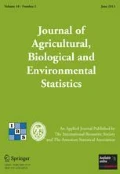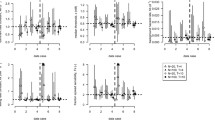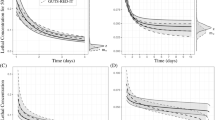Abstract
In aquatic toxicity tests, responses of interest from organisms exposed to varying concentration levels of the toxicant or other adverse treatment are recorded. These responses are modeled as functions of the concentration and the concentration associated with specified levels of estimated adverse effect are used in risk management. While aquatic toxicity analyses often focus on outcomes from a single experiment, laboratories commonly have a history of conducting such experiments using the same species, following a similar experimental protocol. So it is often reasonable to believe that the same underlying biological process generates the historical and current experiments. This connection may facilitate the design of more efficient experiments. In the present study, we propose a simulation-based Bayesian sample size determination approach using historical control outcomes as prior input and illustrate it using a C. dubia reproduction experiment with count outcomes. Simulation results show that precision of the potency estimates is improved via incorporation of historical data. For a standard EPA required test of 60 total organisms, when a single historical control study is incorporated assuming moderate relevance, the mean length (AL) of the \(95\%\) interval of \(\mathrm{RI}_{25}\) (the concentration associated with \(25\%\) inhibition relative to control) is reduced by \(17\%\). So more precision is possible from the historical control data or a reduction of \(40\%\) of the 60 organism would result in the same precision for a pre-specified AL criterion. The incorporation of multiple historical controls assuming moderate relevance would reduce AL by \(37\%\), translating into a reduction of \(70\%\) of the current default sample size.
Supplementary materials accompanying this paper appear online.



Similar content being viewed by others
References
Adcock CJ (1997) Sample size determination: a review. Stat 46:261–283
Bailer AJ, Oris JT (1997) Estimating inhibition concentrations for different response scales using generalized linear models. Environ Toxicol Chem 16:1554–1559
Bailer AJ, Hughes MR, Denton DL, Oris JT (2000) An empirical comparison of effective concentration estimators for evaluating aquatic toxicity test responses. Environ Toxicol Chem 19:141–150
Bernardo JM (1997) Statistical inference as a decision problem: the choice of sample size. An empirical comparison of effective concentration estimators for evaluating aquatic toxicity test responses. Stat 46:151–153
Carr GJ, Bailer AJ, Rawlings JM, Belanger SE (2018) On the impact of sample size on LC50 estimation in acute fish toxicity testing: Is \(N=7\)/Group enough? Environ Toxicol Chem 37:1565–1578
Chen M, Ibrahim JG, Shao Q (2000) Power prior distributions for generalized linear models. J Stat Plan Inference 84:121–137
Cho EA, Bailer AJ, Oris JT (2003) Effect of methyl tert-butyl ether on the bioconcentration and photoinduced toxicity of fluoranthene in fathead minnow larvae (Pimephales promelas). Environ Sci Technol 37(7):1306–1310
Cohen J (2013) Statistical power analysis for the behavioral sciences. Academic Press
Dattalo P (2008) Sample-size determination in quantitative social work research. Oxford University Press
De Santis F (2006) Sample size determination for robust Bayesian analysis. J Am Stat Assoc 101:278–291
De Santis F (2007) Using historical data for Bayesian sample size determination. J R Stat Soc Ser A (Stat Soc) 170:95–113
Douglas MT, Chanter DO, Pell IB, Burney GM (1986) A proposal for the reduction of animal numbers required for the acute toxicity to fish test (LC50 determination). Aquat Toxicol 8(4):243–249
Ellis PD (2010) The essential guide to effect sizes: statistical power, meta-analysis, and the interpretation of research results. Cambridge University Press
Gelman A, Carlin JB, Stern HS, Dunson DB, Vehtari A, Rubin DB (2013) Bayesian data analysis, 3rd edn. Chapman and Hall/CRC
Hobbs BP, Carlin BP, Mandrekar SJ, Sargent DJ (2011) Hierarchical commensurate and power prior models for adaptive incorporation of historical information in clinical trials. Biometrics 67(3):1047–1056
Hobbs BP, Carlin BP, Sargent DJ (2012) Commensurate priors for incorporating historical information in clinical trials using general and generalized linear models. Bayesian Anal 7:1–36
Hutchinson TH, Barrett S, Buzby M, Constable D, Hartmann A, Hayes E, Huggett D, Laenge R, Lillicrap AD, Straub JO, Thompson RS (2003) A strategy to reduce the numbers of fish used in acute ecotoxicity testing of pharmaceuticals. Environ Toxicol Chem 22(12):3031–3036
Ibrahim JG, Chen MH (2000) Power prior distributions for regression models. Stat Sci 15:46–60
Jeram S, Sintes JR, Halder M, Fentanes JB, Sokull-Klüttgen B, Hutchinson TH (2005) A strategy to reduce the use of fish in acute ecotoxicity testing of new chemical substances notified in the European Union. Regul Toxicol Pharmacol 42(2):218–224
Joseph L, Wolfson DB, du Berger R (1995) Sample size calculations for binomial proportions via highest posterior density intervals. Stat 44:143–154
Joseph L, du Berger R, Belisle P (1997) Bayesian and mixed Bayesian/likelihood criteria for sample size determination. Stat Med 16:769–781
Katsiadaki I, Ellis T, Andersen L, Antczak P, Blaker E, Burden N, Fisher T, Green C, Labram B, Pearson A, Petersen K (2021) Dying for change: a roadmap to refine the fish acute toxicity test after 40 years of applying a lethal endpoint. Ecotoxicol Environ Saf 223:112585
Keddig N, Schubert S, Wosniok W (2015) Optimal test design for binary response data: the example of the fish embryo toxicity test. Environ Sci Europe 27:15
Lenth RV (2001) Some practical guidelines for effective sample size determination. Am Stat 55:187–193
Lindley DV (1997) The choice of sample size. Stat 46:129–138
Lillicrap A, Belanger S, Burden N, Pasquier DD, Embry MR, Halder M, Lampi MA, Lee L, Norberg-King T, Rattner BA, Schirmer K, Thomas P (2016) Alternative approaches to vertebrate ecotoxicity tests in the 21st century: a review of developments over the last 2 decades and current status. Environ Toxicol Chem 35(11):2637–2646
Lipsey MW, Aiken LS (1990) Design sensitivity: statistical power for experimental research, vol 19. Sage Publishing
M’Lan CE, Joseph L, Wolfson DB (2008) Bayesian sample size determination for binomial proportions. Bayesian Anal 3:269–296
National Institutes of Health (last updated on November 27, 2018) Enhancing reproducibility through Rigor and Transparency. https://grants.nih.gov/policy/reproducibility/index.htm. Accessed 23 Aug 2021
National Institute for Occupational Safety & Health (last updated on July 13, 2021) Draft-approaches to developing occupational exposure limits or bands for engineered nanomaterials: user guide and technical report https://www.federalregister.gov/documents/2021/07/13/2021-14801/draft-approaches-to-developing-occupational-exposure-limits-or-bands-for-engineered-nanomaterials. Accessed 20 Feb 2022
Organisation for Economic Co-operation and Development (2019) Test No. 203: Fish, Acute Toxicity Test, OECD Guidelines for the Testing of Chemicals, Section 2. OECD Publishing, Paris, France
Pham-Gia T, Turkkan N (1992) Sample size determination in Bayesian analysis. Stat 41(4):389–397
R Development Core Team 2017 (2017) R: A language and environment for statistical computing. R Foundation for Statistical Computing, Vienna, Austria
Rufli H, Springer TA (2011) Can we reduce the number of fish in the OECD acute toxicity test? Environ Sci Technol 30:1006–1111
Russell WMS, Burch RL (1959) The principles of humane experimental technique. Methuen
Stan Development Team (2020) RStan: the R interface to Stan. R package version 2(19):3
Stephenson RR (1984) Evaluation of a rapid range-finding test for use in acute lethality studies with fish. Environ Pollut Ser A Ecol Biol 35:75–81
U.S. Environmental Protection Agency (2002) Short-term methods for estimating the chronic toxicity of effluents and receiving waters to freshwater organisms, 4th edn. EPA-821-R-02-013. U.S. Environmental Protection Agency, Washington, DC
Walker SG (2003) How many samples?: A Bayesian nonparametric approach. Stat 52:475–482
Wang F, Gelfand AE (2002) A simulation-based approach to Bayesian sample size determination for performance under a given model and for separating models. Stat Sci 17:193–208
Wright SE, Sigal B, Bailer AJ (2010) Workweek optimization of experimental designs: exact designs for variable sampling costs. J Agric Biol Environ Stat 15:491–509
Zhang J, Bailer AJ, Oris JT (2012) Bayesian potency estimation in aquatic toxicity testing when a toxicant affects both fecundity and survival of organisms. Environ Toxicol Chem 31(8):1920–1930
Author information
Authors and Affiliations
Corresponding author
Additional information
Publisher's Note
Springer Nature remains neutral with regard to jurisdictional claims in published maps and institutional affiliations.
Supplementary Information
Below is the link to the electronic supplementary material.
Rights and permissions
About this article
Cite this article
Zhang, J., Kong, Y., Bailer, A.J. et al. Incorporating Historical Data When Determining Sample Size Requirements for Aquatic Toxicity Experiments. JABES 27, 544–561 (2022). https://doi.org/10.1007/s13253-022-00496-0
Received:
Revised:
Accepted:
Published:
Issue Date:
DOI: https://doi.org/10.1007/s13253-022-00496-0




